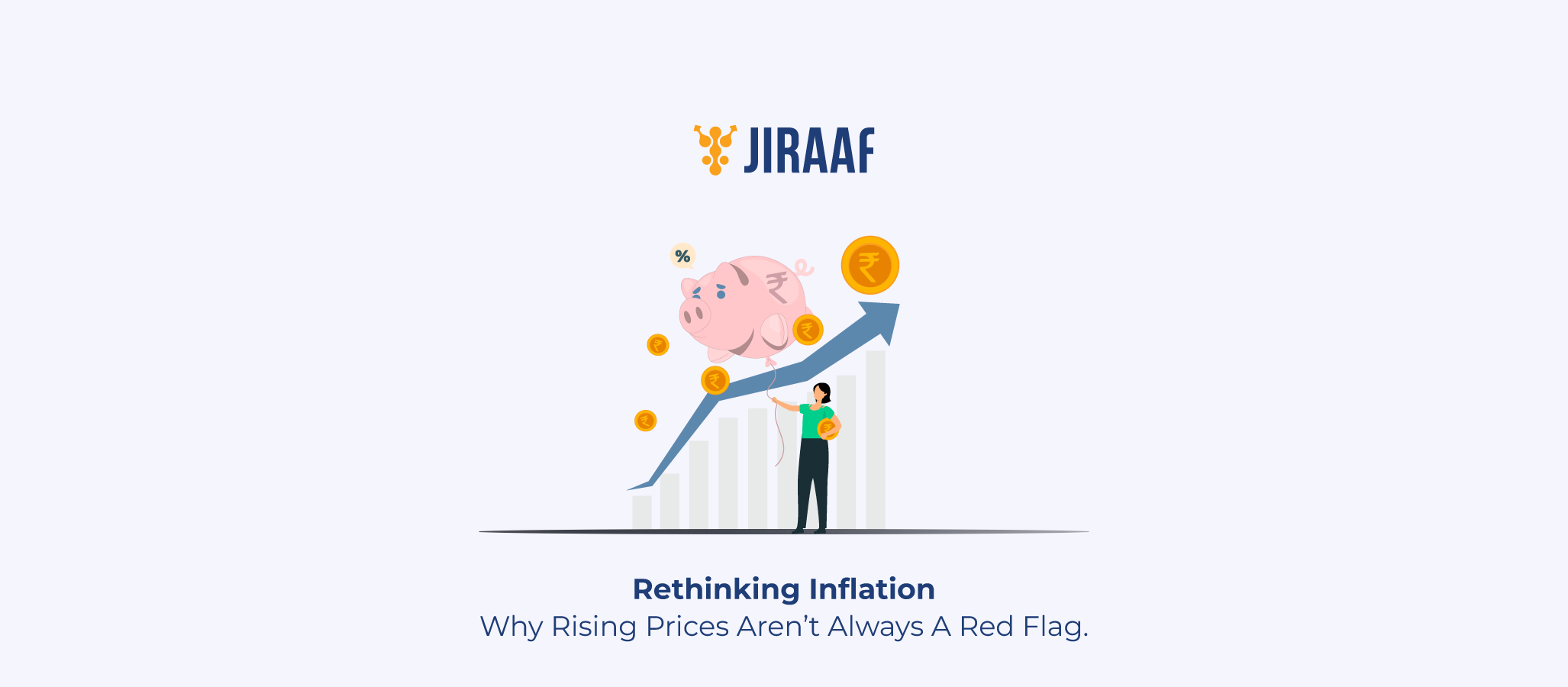Inflation is one of the most frequently discussed and often misunderstood concepts in economics. The inflation narrative is always how it is decreasing the value of money, how ₹500 doesn’t stretch as much as it used to five years back, how price rise is eating up your savings, and so forth.
Inflation touches nearly every aspect of our daily lives, from the cost of a morning cup of tea to the broader health of national and global economies. The inflation rate shapes a country’s monetary policy, keeping media outlets buzzing ahead of the release of inflation numbers. The current inflation rate in India is hovering around 3%. If inflation is truly the villain it is portrayed to be, should the RBI aim for 0% inflation and strive to maintain stable prices? Or, should the RBI work towards maintaining a healthy, yet steady rate of inflation in India?
This article seeks to examine the multifaceted nature of inflation, exploring its causes, types, and implications, particularly in the Indian context, and whether its reputation as an economic threat is always warranted.
What Exactly is Inflation?
Inflation is the rate at which prices for goods and services rise, eroding purchasing power over time. In simpler terms, your ₹500 buys you a little less than it did last year.
Economists believe that inflation is a result of an imbalance between supply and demand in the economy, often caused by an increase in the money supply. The post-pandemic surge in inflation across developed and developing economies in North America, Europe, and Asia was a result of increased money supply in the form of bailout packages and social security aid during the pandemic year, aimed at maintaining consumption.
While inflation is one of the most talked-about economic indicators, it isn’t always catastrophic. Economies are living, breathing systems. As demand grows, prices must adjust. When this rise is steady and predictable, it signals that people are working, spending, and consuming. In such a scenario, inflation is not a monster under the bed—it’s more like the pulse of progress.
The Flavors of Inflation
Not all inflation is the same. Economists recognize several types of inflation, each driven by different forces.
Demand-pull inflation arises when more money chases fewer goods. Imagine a festival season with booming demand: sellers know they can raise prices, and buyers still queue up. It’s a sign of a thriving economy—up to a point.
Cost-push inflation, by contrast, originates from the supply side. If transport becomes costlier due to rising fuel prices or crops fail, sellers increase prices to protect margins. This inflation hurts more because it’s not a reflection of economic prosperity, but rather a sign of scarcity or inefficiency.
Built-in inflation is an economic echo. Workers demand higher wages to match rising costs. Employers raise prices to cover higher salaries. The loop feeds itself unless broken by external intervention, often from a central bank.
Irrespective of the causes of inflation, the price rise and the reduction in purchasing power of money are always the end results.
Causes of Inflation in India?
The inflation story is a complex braid of global dependencies and local sensitivities.
Global vs. Domestic Triggers
Global triggers impact inflation in India, as we are a net importer of crude oil, pulses, and edible oils. Any geopolitical shock that affects the price of crude oil also impacts inflation rates in India. A war in Europe? Petrol prices spike in Pune. Drought in Brazil? Soya oil costs shoot up in Chennai.
Domestically, inflation is shaped by monsoon patterns, supply chain bottlenecks, government subsidies, and Minimum Support Price (MSP) policies. A poor onion harvest can have more political and economic impact than a stock market crash. India’s inflation is particularly food-sensitive, and food inflation disproportionately affects the financially vulnerable.
While a range of factors can impact inflation, it is the central bank’s job to control inflation. Here are the mechanics of inflation in India and how the Reserve Bank of India (RBI) manages inflation.
India’s Inflation Mechanics
In India, inflation is monitored through two key indices, each offering distinct insights into price movements across consumer and wholesale markets. These measurements not only shape public perception but also inform critical monetary policy decisions by the Reserve Bank of India. Let’s examine how inflation is quantified, what current trends reveal, and the role of policy in maintaining economic stability.
How Do We Measure Inflation in India?
India used two indices— the Consumer Price Index and the Wholesale Price Index —to quantify inflation. Both the CPI and WPI inflation numbers are announced every month.
- Consumer Price Index (CPI): Reflects what urban and rural households pay for daily essentials, from rice and vegetables to clothes and school fees.
- Wholesale Price Index (WPI): Captures price movements at the wholesale level, before the goods hit the shelves.
The Reserve Bank of India uses the Consumer Price Index as its benchmark, targeting an inflation range of 2% to 6%, with 4% as the ideal midpoint.
What’s Happening Right Now?
The CPI for April 2025 came in at a highly favorable number of 3.16%, whereas the WPI came in at 0.85%. The CPI number is the lowest since July 2019 and comfortably below the RBI’s 4% target range.
Additionally, the RBI expects inflation to remain around the 3% mark, owing to a favorable summer with no heatwave days in May and an early onset of the monsoon, with an above-average prediction. While domestic factors remain constant, geopolitical risk stemming from the Ukraine-Russia and Israel-Gaza conflicts can spur an increase in crude prices, negatively impacting inflation.
RBIs Role in Controlling the Inflation Rate in India
Milton Friedman famously said inflation is caused by too much money chasing too few goods, pointing to the supply of money in the economy.
The RBI controls the circulation of money in India, and hence, a loose monetary policy results in an excessive money supply. In contrast, a conservative economic policy can starve the supply of money. It is the RBI’s job to maintain the optimal supply of money that is just a little above the demand for money in the economy.
The RBI, to maintain steady inflation, uses monetary policy instruments such as the repo rate, reverse repo rate, standing deposit policy, and cash reserve ratio to manipulate the supply of money in the economy.
Higher repo rates discourage borrowing and spending, cooling demand. Lower rates do the opposite. It’s a dance of balance: too aggressive, and the economy slows; too soft, and inflation runs amok.
As discussed above, the inflation rate is coming down. Should the RBI use the monetary policy tools to bring down the inflation rate to zero, putting the price debate to rest? We need to understand the concepts of inflation, deflation, and disinflation to determine if zero or negative inflation can help India.
Inflation vs. Deflation vs. Disinflation
Inflation is defined as the general price rise in the economy. While inflation is an economic indicator when it comes to demand- and supply-related price changes in the economy, it is not the only one. Inflation cannot be understood in silos because the absence of inflation and cooling inflation are two distinct phenomena, which, although related to inflation, paint a very different picture about the economy’s status. Understanding the concepts of deflation and disinflation will help you comprehend the various facets of inflation.
- Deflation
Deflation is the exact opposite of inflation, defined by a sustained fall in prices. This might sound great, but it’s often seen as the most significant economic red flag. Deflation in an economy occurs when consumers postpone purchases, expecting prices to drop further. Businesses lose revenue, and the economy enters a vicious cycle, ultimately pushing it into recession.
- Disinflation
Disinflation is the absence of inflation, defined by a cooling of inflation, often as a result of policy moves. This is generally followed by a period of high inflation, where the central bank steps in to counter the spiraling price rise.
In this spectrum, mild inflation is the “just right” zone economists aim for: enough to encourage spending and investment, not so much that it causes panic.
Deflation and Japan
Deflation sets in when prices start to fall in an economy. The immediate impact could be positive on consumers, but the long-term consequences can be deeply damaging. Japan offers a textbook example of how deflation can grip an economy and resist even aggressive policy interventions.
Beginning in the 1990s, Japan entered a prolonged period of economic stagnation and deflation, often referred to as the “Lost Decades.” With consumer prices falling or remaining flat, people delayed spending in anticipation of even lower prices, while businesses scaled back investment and hiring. This behavior created a vicious cycle of weak demand, reduced earnings, and further economic slowdown.
In response, the Bank of Japan (BOJ) adopted unprecedented monetary measures. Its primary mandate was to achieve sustainable price stability, leading it to implement a super-accommodative policy: negative short-term interest rates, caps on long-term yields, and large-scale fiscal stimulus programs. Most notably, in 2016, the BOJ introduced negative interest rates, charging commercial banks 0.1% on excess reserves to encourage lending and fuel spending.
Despite these interventions, Japan spent nearly three decades struggling to lift prices. Even as inflation rose to 4.2% in early 2023, the highest level in 40 years, and wages experienced their most significant increases in decades, the Japanese government has remained cautious.
Japanese officials argue that reversing deflation isn’t just about rising prices—it requires a psychological shift. Households and businesses must believe that inflation, not deflation, is the norm.
Japan’s case underscores how deflation is not merely an economic condition but a deep-rooted mindset. And once it takes hold, even bold monetary experiments may take decades to unwind their grip.
A Healthy Dose of Inflation is Good
Zero inflation may sound like an economic paradise, but it’s more like a desert. Prices freezing in place also means wages stagnate, business revenues flatten, and consumer activity slows. It becomes harder for central banks to respond to recessions when there’s no inflation buffer.
Moderate price increases can fuel economic growth. If consumers spend less and save excessively, overall demand falls, slowing production, increasing unemployment, and stalling the economy, a dynamic known as the “paradox of thrift”, as coined by British economist John Maynard Keynes.
In contrast, controlled inflation encourages spending, prompts businesses to invest, raises wages, and fosters job creation. As income and demand rise in tandem, this positive cycle boosts productivity and sustains growth, highlighting that a certain level of inflation can be both natural and necessary.
So, is Inflation Always Bad?
No. In fact, the answer to this is layered, like the economy itself.
Inflation is not a sign of doom. It’s a signal. It tells us the economy is breathing, growing, and adapting. Yes, runaway inflation can destroy savings and widen inequality. However, zero inflation can also hinder progress just as effectively.
The goal isn’t to eliminate inflation, but to manage it. Like the air conditioner your h home, it needs temperature adjustment, not eradication.
So, the next time your cup of filter coffee costs ₹5 more, don’t just wince. Consider it a ripple in the current of economic life—and maybe, just maybe, a sign that the wheels of progress are still turning.
Discover fixed income investments with Jiraaf, a SEBI registered online bonds platform that educates and brings access to a wide array of bonds. Sign up today to explore diversified fixed income investment opportunities to support your goal-based wealth creation journey. Start investing!



